|
On a rainy afternoon
in 1951, Judith Shutt and her family saw The Laurey
Puppets (later of "Mr Turnip" TV fame) while on a
seaside holiday - an event which was to change all of
the Shutt family's lives thereafter. The whole
family enjoyed the Laurey Puppets enormously and as they
left the show,
they saw a poster advertising a Puppet Exhibition at the
Royal Hotel, Woburn Place, near Russell Square, London,
organised by the British Puppet and Model Theatre
Guild.
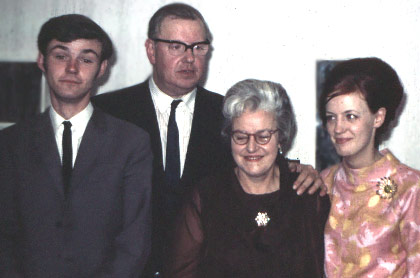
The family decided
to attend the 1951 Guild Exhibition, but as they were not
members, they had to stand in a long queue to gain admission.
The wait was worthwhile, because once inside, they met
H W Whanslaw, who
encouraged them to become more involved in puppetry and
Whanslaw's books became required reading over the coming
months.
In an article for "The
Puppet Master" Magazine in 1996, Judith recalled:
"The first puppet my Father (Ernest) made was a
little 10-inch Pinocchio. I think it was inspired
by Eric Bramall's Kasperl. I still have him
today."
"Christmas
morning 1952 and my brother Plugg (Ernest Jr) and I were
up early, as kids are on that morning. Around the
tree were the small presents but hanging from the
curtain pelmet were two big puppets - 18 inch high -
Carmen Miranda and a South American Guitarist. So
the whole Christmas was spent practising. My
Mother (Muriel) had at last found something she could
use her Art School training on as a dress designer."
"By the time the
Coronation came in June 1953, I think we had about six
puppets. Our first show was a Street Party.
It must have rained, because we did the show indoors in
a small factory in Raymouth Road, Bermondsey. Dad
looked after the sound on 78 rpm records, Ma, Plugg and
I all worked a puppet or two. On the way home, we
decided 'The Shutt Marionettes' did not sound right.
Dad came up with the name "MEJANDES" - Muriel,
Ernest, Judith AND Ernest
Shutt."

This exciting new family activity rapidly
developed and soon the whole family were heavily
involved in the various building, sculpting and
performing tasks required to run a successful marionette
troupe. Judith also found time during this period
to work as a Pelham Puppets Demonstrator for
several seasons at Hamley's Toy Shop in Regent
Street, London.
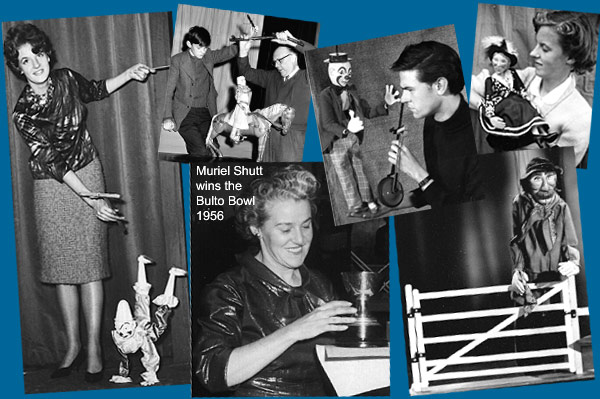
It was around this time that fellow puppeteer and
Guild Member, Christine Glanville, who had been
working for AP Films,
contacted Judith to say that they were looking for a
new floor puppeteer and would she be interested in
applying? Judith soon found herself working with
Christine Glanville and Mary Turner on
Fireball XL5, the first of many TV series in a long
and distinguished association with television puppetry.
|
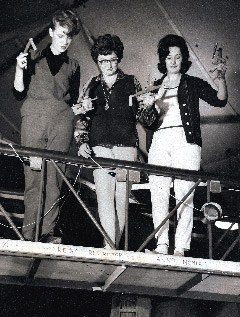 |
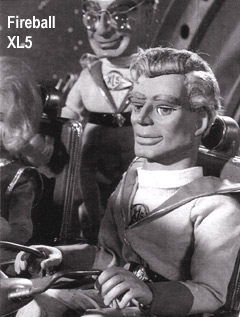 |
Filming for Fireball XL5 was divided
between two teams that shot in tandem and on two
shooting stages; the largest of which housed the main
sets and a large marionette bridge that was suspended
from the roof. Filming took place over a period of
a week to ten days and then moved to a smaller stage
that had a moveable bridge. For the puppeteers,
this involved spending many long hours in awkward
positions, high above the stage in the heat from lamps,
supporting quite heavy puppets and as the marionettes
were fitted with electro-magnets to activate their
mouths, the puppeteers would frequently receive electric
shocks if the wires crossed.
Following Fireball, the next TV series,
Stingray, entered pre-production and the studio
puppeteers re-located back to the puppet workshop to
start assisting with the build of the new characters.
The whole process lasted 6 months. The puppeteers had to be multi-skilled and proficient in
construction of the figures as well as their operation.
Although the raw materials for puppet construction were
rapidly changing in terms of sophistication and
durability, the basic principles of the traditional
marionette remained the same.
Stingray was again hugely popular with TV
viewers and so followed the most successful and
best remembered of the Gerry & Sylvia Anderson
productions - Thunderbirds.
With each new series,
the design style had moved more and more towards realism
and with Thunderbirds, this manifested itself by the
characters being,
for the most part, shot from the waist up, static,
seated or in craft - all intended to avoid the marionettes
ever being seen
walking!
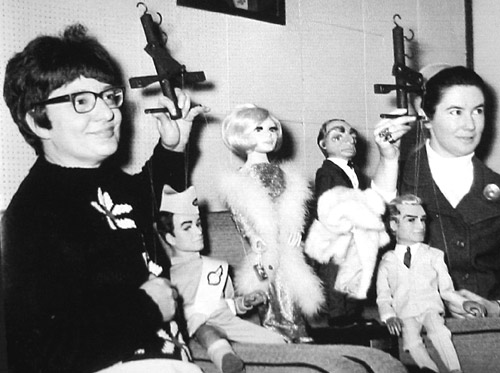
After working on the three TV series and
also the two spin-off cinema films from the Thunderbirds
series - "Thunderbirds are Go" and "Thunderbird
6" this had been a very intense period of production
and Judith decided the time had come to move on and
discover new horizons.
The Mejandes Marionettes were still
presenting live shows during Judith's time with AP Films
and also making and operating puppets for other people.
Muriel and Plugg worked with John Dudley for a Summer
Season at the Winter Gardens, Eastbourne and made
puppets for the Dudley Marionettes' The Tempest
production among others.
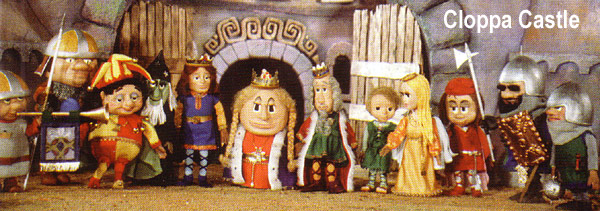
In 1969, Mary Turner and John Read formed
their own specialist puppet film production company
Cinemation, described by fellow puppeteer Sue Dacre as "a magical place to work".
Judith was asked to join them from the start, for their
first commission for ITC The Adventures of Rupert
Bear. Over 100 episodes were made with Mary
Turner now directing, designing and sculpting, as well
as co-producing with John Read. Many other series
followed which have since become Children's TV Classics,
with Here Comes Mumfie and Cloppa Castle
being among the most fondly remembered.
Since the puppet with strings fell out of
favour with the TV camera, Judith has remained a
powerful and respected voice in British Puppetry, both
as a maker and in her tireless work behind the scenes
for the British Puppet & Model Theatre Guild.
Plugg had joined Judith to work on
Thunderbirds and stayed on with AP Films, continuing his
career in the world of Film Special Effects.
In addition to being remembered for her
puppetry, the Guild's Lifetime Achievement Award is
named in Muriel Shutt's honour.
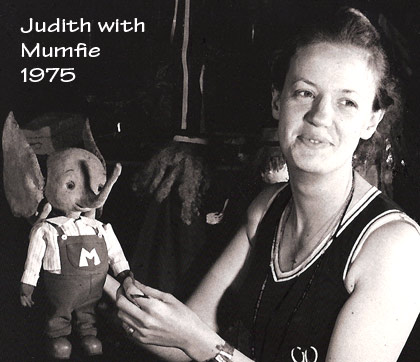 |